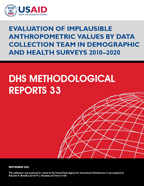- PUBLICATIONS
- JOURNAL ARTICLES
- ACCESS PUBLICATIONS
Publications Summary
- Document Type
- Methodological Reports
- Publication Topic(s)
- Anthropometry/Biomarkers, Survey Methodology, Data Quality, Analysis
- Country(s)
- Angola, Benin, Burkina Faso, Burundi, Cameroon, Chad, Congo Democratic Republic, Cote d'Ivoire, Gabon, Gambia, Guinea, Kenya, Lesotho, Liberia, Malawi, Mali, Mozambique, Namibia, Niger, Nigeria, Senegal, Sierra Leone, South Africa, Tanzania, Togo, Uganda, Zambia, Zimbabwe, Albania, Armenia, Egypt, Jordan, Yemen, Kyrgyz Republic, Tajikistan, Bangladesh, Cambodia, India, Maldives, Pakistan, Timor-Leste, Papua New Guinea, Dominican Republic, Haiti, Honduras, Peru
- Language
- English
- Recommended Citation
- Benedict, Rukundo, Sorrel Namaste, and Trevor Croft. 2022. Evaluation of Implausible Anthropometric Values by Data Collection Team in Demographic and Health Surveys 2010–2020. DHS Methodological Reports No. 33. Rockville, Maryland, USA: ICF
- Download Citation
- RIS format / Text format / Endnote format
- Publication Date
- September 2022
- Publication ID
- MR33
Download
 Evaluation of Implausible Anthropometric Values by Data Collection Team in Demographic and Health Surveys 2010–2020 (PDF, 2218K)
Evaluation of Implausible Anthropometric Values by Data Collection Team in Demographic and Health Surveys 2010–2020 (PDF, 2218K)
Download this publication
There is no printed copy available to order.
